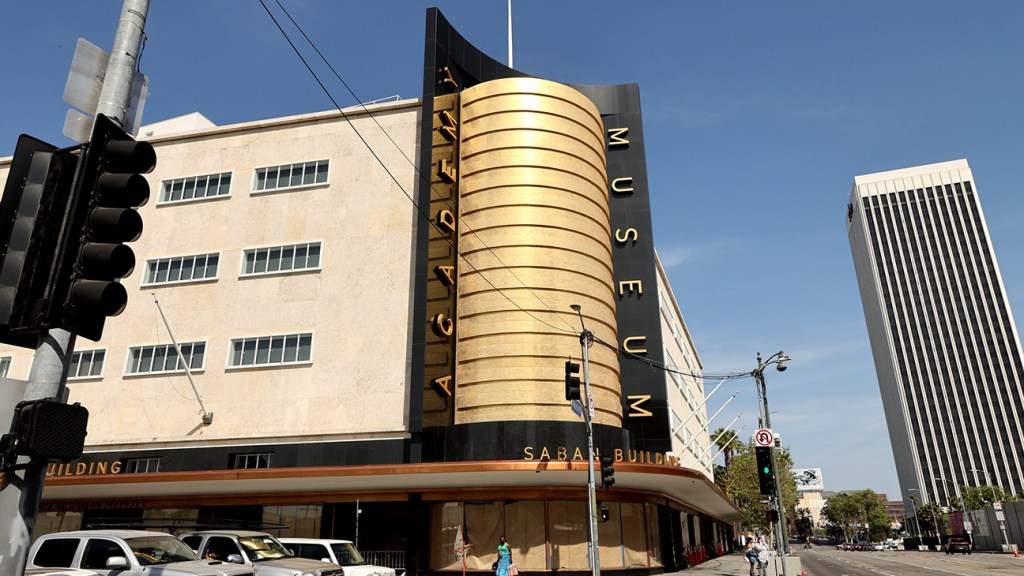
Academy of Cinema Museum
Kevin Winter/Getty Images
The Academy Museum of Motion Pictures was a commercial success and a critical failure.
At a time when Oscar ratings are down, the new institution’s robust ticket sales—it has welcomed nearly 2 million visitors since it opened in September 2021—have made it a major Los Angeles attraction, bolstered the Academy’s coffers and prompted the museum’s inaugural director, Bill Kramer, to become CEO of AMPAS, the parent organization. Yet with the exception of Regenerationits acclaimed and in-depth showcase of black American cinema through the early 1970s, the exhibitions have been misfires of discourse, more suited to the local tourist attraction it is than the world-class institution it aims to be.
The fan service was exuberant (a tribute to Hayao Miyazaki, the master of Japanese animation) and the spotlight was on illustrious but lesser-known luminaries like editor Thelma Schoonmaker and director Oscar Micheaux. The museum also devoted its first study to the film industry, which has been maligned for what was seen as an anxious, overcompensating political correctness, coupled with a narrow-minded view that ignored the Hollywood studio system and its founders. Film historian Sam Wasson’s article was titled “Little Gold Men, Big White Guilt.”
This spring, the museum tried to correct that by taking a look at the Jewish immigrant moguls who launched the movie industry. HollywoodlandThe exhibit was roundly criticized by a group of disgruntled entertainment professionals, including mogul Casey Wasserman, producer Lawrence Bender, actor David Schwimmer and writer Amy Sherman-Palladino. In a letter, they called the exhibit “anti-Semitic” because of its emphasis on the well-researched but unappealing biographical facts of its subjects, including misogyny and greed. Director Alma Har’el, who had served on the museum’s inclusion committee, resigned after seeing the exhibit.
Others have countered the criticism. The New Yorker writer Michael Schulman, who has covered the Oscars and the film industry, argued “Their legacies are extremely varied” and “to turn away from them is to follow the Ron DeSantis school of history.” Nevertheless, the museum has since apologized for “using language that could unintentionally reinforce stereotypes” and announced the creation of a panel of outside experts, including current and former directors of several Jewish-themed museums, to advise on promised changes to the exhibit, some of which have since been implemented. “I felt sad and angry when I saw the redacted version,” Schulman wrote after visiting the revised exhibit. (Neal Gabler, author of the seminal book on Jewish founders, An empire of their ownconsulted on the initial presentation of Hollywoodland.)
This latest controversy highlights the major problem facing the Academy Museum. Its mission is not just to celebrate cinema, but to “contextualize and challenge dominant narratives around cinema.” In other words: to challenge what is still a century-old medium with the same seriousness that curators have long accorded to much more established arts and sciences. Yet it currently lacks the capacity to fulfill this mandate.
I have long covered nonprofit governance for The Hollywood Reporter and I chronicled the genesis and development of the Academy Museum before it was even built. The exhibition experts I spoke with a decade ago had already identified the fundamental tension between the institution’s ostensible ambitions and its stewardship of inherently conflicted constituencies. Even then, they worried that the museum’s structural proximity to Hollywood would undermine its credibility. “It’s a spider’s web,” Sandra Garcia-Myers, USC’s film arts librarian, observed at the time. “Are they going to ask the tough questions? And if they don’t, at least discuss them? You’ll be able to tell within a year—if only from the exhibitions they open—whether this is a serious curatorial mission or some kind of Disney attraction.”
AMPAS knows how to maintain and protect rigorous institutions. Evidence of this can be found in its Pickford Center for Motion Picture Study, a vast film archive, and its Margaret Herrick Library, a world-renowned repository of Hollywood documentation.
But his new museum, which enjoys a prime location on the LACMA campus, tends to pander to the masses. Worse, it seems afraid to provoke. That’s unfortunate, but manageable when it’s making movies that appeal to audiences, like the upcoming sci-fi series “Cyberpunk.” It’s fatal when it’s supposed to do much more than that: serve as a crucial, unwavering intellectual voice, especially as the movie world grapples with its existential crises, from the collapse of movie theaters to the encroachment of AI.
What the museum lacks now that it’s up and running is the curatorial confidence that comes with proper management. Its 28-member board is stacked with heavyweights, a mix of admired entertainment names (Miky Lee, Tom Hanks, Jim Gianopulos) and business professionals who can be counted on to help with fundraising and political headaches. What’s conspicuously absent are any of them figures with deep experience and leading large and ambitious museums – with the exception of the symbolic seats occupied by Kramer, as well as the museum’s recently appointed director, Amy Homma. None of them have been made available The Hollywood Reporter to discuss their approach; none of them have any experience in conservation.
The board needs respected figures from the museum world who can better assert their independence, which in this case means being a bulwark against ideological and corporate interests. (A film exhibition center is bound to face private pressure and public testing over the display of material owned by the companies that fund it.) Increasing the number of board members, or expanding the existing group, would improve the situation.
The Academy Museum undoubtedly benefits from the aegis of AMPAS and its members and affiliates. But it will not be able to realize its declared aspirations until it has properly isolated itself from the entity that gave birth to it.